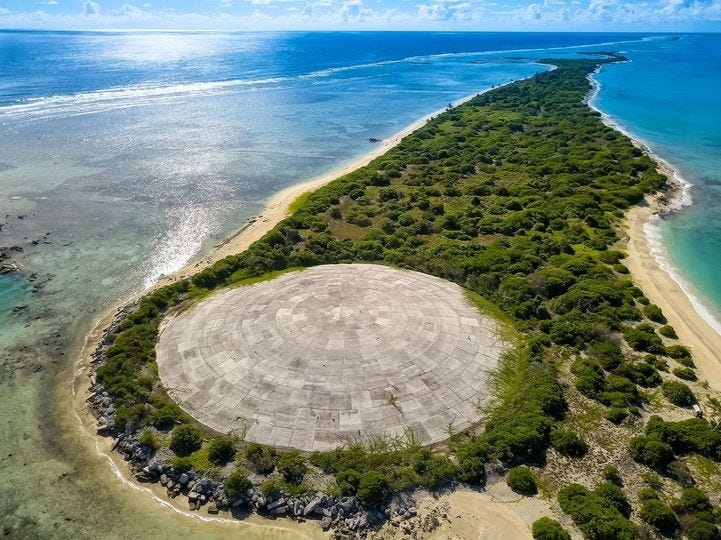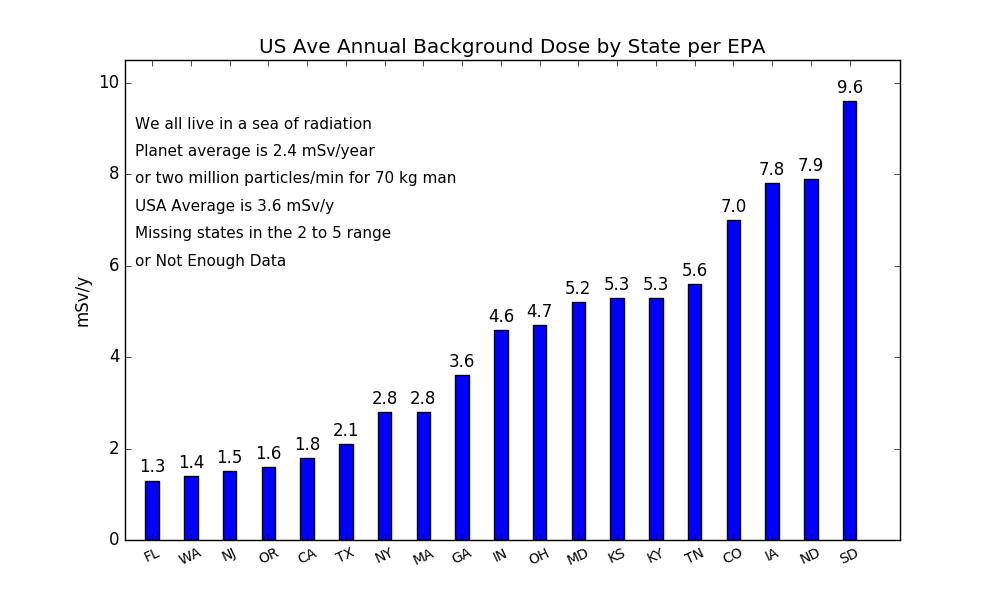LNT is prudent.
If you don't pursue safety in a way that is cost effective, you are killing people.[David Okrent]
A few weeks ago, the GKN posted a piece claiming this was the last time we would kick the dead horse called LNT. Several members of the choir scoffed at the claim, pointing out that LNT was not only very much alive; it was kicking the excrement out of nuclear. It seems even the choir can be right once in a while. Quite surprising.
Figure 1. The Runit Dome. 6 men died here in construction accidents.
Whenever LNTers are confronted with data contradicting LNT, they fall back on the prudence argument. LNT may be badly wrong for low dose rate profiles; but it should still be used for regulatory purposes, because it is simple and conservative, a safe fiction. But a model that is conservative by orders of magnitude at the dose rate profiles experienced in a nuclear power plant release brings with it enormous costs to humanity.
In the mid-70's, the US decided to ``clean-up" the northern end of Enewetak Atoll, site of 43 bomb tests between 1948 and 1958. The clean up consisted mainly of digging up land, tossing it into one of the bomb craters, and then covering the crater with concrete.
The resulting ``Dome" is on Runit Island. Periodically, it is visited by TV crews deploring how man has made the tiny island uninhabitable for thousands of years. Sometimes they broadcast from the top of the low dome. But they never tell us the dose rates they are braving.
In 2015, Columbia University visited the Dome and took some measurements.\cite{bordner-2016} Turns out Enewetak is a very low background dose area. The gamma dose rate on the top of the dome is 0.18 mSv/y. At the base, it is 0.43 mSv/y. The mean for Runit was 0.13 mSv/y with large relative dispersion. Columbia uses New York's Central Park as their reference. Columbia's measurements for Central Park range from 0.13 to 2.13 mSv/y with a mean of 1.00 mSv/y.
The clean up required an Environmental Impact Statement. EIS rules require you analyze the Do-Nothing option. According to the EIS and LNT, Do-Nothing would result in a 3 in one thousand increase in cancer incidence for someone living in the area for 30 years.\cite{church-2000} This means the 1977 ambient dose rate above background in the area, 20 years after the last test, was about 1 mSv/y (0.00274 mSv/d), Central Park numbers. The SNT Lost Life Expectancy from 0.00274 mSv/d for 30 years is 2.3 seconds.
The clean up went ahead anyway. It was a three year project, 1977-1980, involving 8033 people. Six of these men lost their lives in construction mishaps. There were 63 lost time accidents.\cite{church-2000} One of the radiation specialists assigned to the job was Bruce Church. He had been a compliant supporter of LNT. After this experience, he changed his mind, saying he abhorred LNT because ``it transferred hypothetical, computed harm to real harm to real people."
There is nothing prudent about LNT's massive over-conservatism for low-dose rate profiles. In a release, it creates panicked, ill-advised, deadly evacuations. We killed 50 frail, elderly people at Fukushima almost immediately. We pulled them from their beds, bussed them to areas that had no medical facilities, and left them to die. That's not prudence. That's murder.
Then LNT's monomanical focus on total dose, regardless of the dose rate, dictates that these evacuations turn into unnecessary multi-year and multi-decade exiles. People are not allowed to return home to areas where the dose rates are less than background dose rates in parts of the planet where humans have thrived for tens of thousands of years. Hundreds of thousands of people at both Chernobyl and Fukushima had their lives needlessly ruined. This is prudence?
The craziest of the evacuations happened in 1990. Four years after Chernobyl, well after everything had settled down, 220,000 people were forcibly evacuated from any area where the cesium ground contamination was more than 555,000 Bq/m2. The reasoning was 555,000 Bq/m2 would result in a cumulative dose of 100 mSv for a person who lived there for 70 years. According to LNT, a dose of 100 mSv will increase your lifetime chance of cancer by 1%. The region around Chernobyl is a low background dose area. The cesium lifted the dose rate in this region to at worst 7 mSv/y. Four American states have average background dose rates higher than 7 mSv/y, Figure 2. We find no increase in cancer in areas where background dose rates are 60 mSv/y.\cite{nair-2009}
Figure 2. USA states average dose rate.\cite{mauro-2005}
Here's how the National Council on Radiation Protection puts the prudence argument.
... no alternative dose-response relationship appears more pragmatic or prudent for radiation protection purposes than the LNT model.\cite{ncrp-2018}[p 9]
The LNT model is practical because it is easy to apply and prudent because it is unlikely to underestimate risk at low doses.\cite{ncrp-2018}[p 10]
But the NCRP offers no cost-benefit analysis supporting this claim of prudence. It makes no attempt to show that society comes out ahead by making nuclear so expensive it cannot compete with coal in generating electricity. For good reason. It turns out nuclear electricity kills roughly 300 times less people per kilowatt-hour than coal electricity.
In theory, the radiation protection establishment accepts the fundamental principle that radiation protection measures should do more good than harm.\cite{icrp-2007} This is called justification But in practice, the definition of prudence is minimizing radiation exposure regardless of other costs, a myopic, self-serving definition that already has killed many thousands of people and could kill the planet.




Radiation exposure is an easy "event" to dramatize as "very dangerous", regardless of the reality.
Your efforts to bring some sanity to this whole arena are to be lauded.
Thinking about possible measures to better protect those elderly Japanese moved and left in less than commodious situations, I was wondering if a set of converted shipping containers could serve some superior temporary protective role in such cases? Fly them in, pre-engineered with ventilation and suitable filtration, etc. Add layers of lead cladding if that is appropriate? Or even just as temporary command posts for responders to use while adding local people to cope?
I keep looking for technical assistance or solutions, when I suppose the real problem is bad intellectual thinking and overly reactive psychology.
Very well Said